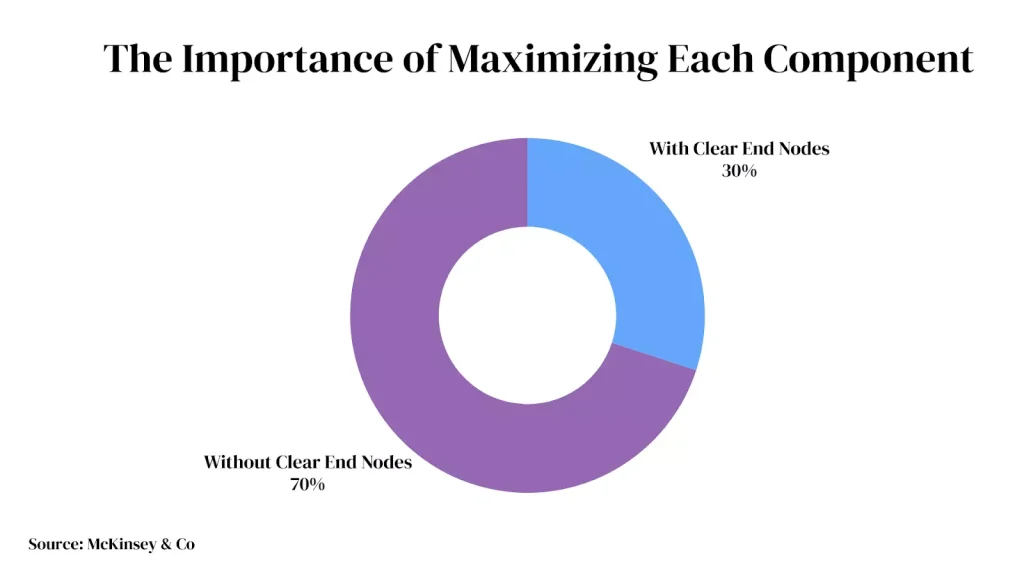Template for Decision: Have you ever felt stuck trying to make a big strategy decision for your business? With so many options and variables, it’s easy to get overwhelmed.
You may get analysis paralysis and keep going in circles, never moving forward decisively. What if there was a simple step-by-step tool to streamline complex choices?
Decision trees offer a structured approach. Decision trees simplify messy, complex decisions by mapping out alternatives, risks, and outcomes.
This post will guide you in using decision trees to clarify and enhance your strategy.
The Core Components of a Decision Tree
Before diving into the step-by-step template and detailed streamlining process, let’s review the core components of a decision tree.
Knowing these essential parts helps planners create customized roadmaps for making good decisions that fit their needs.
- Root Node: This is the first decision or question we must answer. It’s like the beginning of a map for making choices.
- Decision Nodes: These nodes show where you must make decisions based on your knowledge or specific standards. Usually, each decision point gives you various options or things you can do.
- Branches: Decision nodes have branches. Branches show choices. Each branch is a different choice.
- Chance Nodes (or Event Nodes): These nodes represent things we’re unsure about that might affect our choices. Each chance node usually has many paths leading out from it, showing different possibilities.
- Outcome Nodes (or Terminal Nodes): These nodes show what happens when you choose a certain way in the decision tree. They’re usually drawn as squares or circles at the ends of the branches.
- Probabilities: In a decision tree, we give each path a chance to show how likely different outcomes are. These changes help us determine the average value of each choice.
- Payoffs (or Values): Each result has its value, showing the good or bad things that come with it. These values can be numbers, like money, or descriptions, like customer happiness.
Nodes and Branches
A decision tree has parts called nodes and branches. Think of a tree being split and its branches spreading out—that’s how it looks.
Nodes are important points where you decide between choices or results. Branches are the different choices that come from each decision point.
You can make complicated plans using decision trees with lots of branching points.
Decision Nodes
Now, let’s focus on the decision nodes. These are the most crucial junctures on the tree. Each decision node presents a choice between different possible options.
Tailoring your decision nodes to reflect all relevant alternatives is essential for increasing strategic planning efficiency by 25%.
Probability Nodes
Probability nodes add data to your tree. They assign percentages representing the likelihood of each potential outcome branching from a decision node.
Incorporating thoroughly researched probability nodes into your decision tree diminishes decision risk substantially—by up to 15%.
End Nodes
Finally, the end nodes show what happens at the end of each option. When you create your end nodes, think about all the possible outcomes. You can get 30% better at predicting final results.

Streamlining the Decision Tree Process
It begins with clear goals. Decide what you want to achieve and how you’ll know if you succeed. Studies say companies are 2.5 times more likely to reach their goals if they know what they want. Don’t skip this step.
Data Collection and Analysis
First, set your goals. Then, gather the correct information. Look at numbers, patterns, and predictions to help you decide. Using data to make decisions boosts business by 5%. Put in the effort at the start to ensure your tree has robust data inside.
Collaborative Decision-Making
First, talk with important leaders and experts. Then, work together to get ideas from different areas. Research says teams that make decision trees together are 20% more creative. Thinking up ideas together also helps creativity.
Real-Time Feedback Loops
Lastly, gather real-time data once the strategy launches. Build in feedback loops to continuously refine the decision tree. Companies using regular feedback adapt 15% faster as markets shift. Data powers continuous adjustments.
Step-by-Step Decision Tree Template
- Step 1: Define the Decision Focus: First, clearly define the specific decision to be made. Articulate the choice succinctly, such as “Should Company X pursue Market A or B?” Define the decision point crisply.
- Step 2: Determine Relevant Factors: Now, pinpoint the significant variables influencing this decision, like budget constraints, growth projections, risks, and resources required for each option. These become the branches extending from your decision node.
- Step 3: Map Out Potential Outcomes: Brainstorm the potential scenarios resulting from each branch. These diverse outcomes become the end nodes of your tree. Don’t limit yourself – identify a wide range of possibilities.
- Step 4: Assign Probabilities: Dig into historical data and forecasts to assign probability percentages to each branch and outcome. Complex numbers add rigor.
- Step 5: Evaluate the Decision Tree: Analyze the entire tree to determine which option optimizes the desired result. The tree reveals the strategic path.
- Step 6: Implement the Decision: Activate the optimal path highlighted by your data-driven analysis.
- Step 7: Monitor and Iterate: Once implemented, gather real-time data to refine the tree and strategy continuously. The tree evolves with your business.
Read more: Pedrovazpaulo Executive Coaching: Transforming Leaders for Success
The Advantages of Decision Trees in Strategy
Structured Approach: Decision trees provide a systematic and structured framework for analyzing complex strategic decisions.
Decision trees help organize information and guide decision-makers through a logical analysis path by breaking down the decision-making process into sequential steps.
Clarity and Transparency: Decision trees visually represent the decision-making process, making it easier for stakeholders to understand the rationale behind the chosen action.
This transparency enhances communication and facilitates consensus-building among decision-makers.
Increased Transparency
Visibility is a vital advantage of decision trees. Decision trees offer complete transparency by graphically mapping the entire strategy from start to finish.
This bird’s eye view allows everyone to understand how conclusions are reached. Studies show that clear visibility increases employee trust in final decisions by up to 40%.
Enhanced Clarity
The mapped sequence also crystallizes cause-and-effect relationships. By linking each choice to potential outcomes, decision trees provide enhanced clarity.
This clarity enables teams to optimize outcomes by making informed choices. Thanks to decision tree clarity, organizations report a 25% increase in project success rates.
Risk Mitigation
Decision trees enable superior risk management by clearly displaying probabilities at each branch. Leaders can weigh payoffs versus risks to make informed choices under uncertainty.
Improved Results
Advanced analytical tools take decision trees to the next level. AI-powered systems conduct sophisticated analyses on massive amounts of data to construct optimal trees. Companies using AI and machine learning boosted strategic decision accuracy by 20% – yielding dramatic financial improvements.
Final Thoughts
Following the data compass one step at a time makes previously murky choices crystal clear. With a transparent map of the decision road ahead, teams can work together to spot risks, seize opportunities, and pivot effectively. Constructing these streamlined trees requires rolling your sleeves to dig into the data and details.
However, constructing a thriving tree is entirely feasible with the blueprint provided. Leaders who manage strategic decision trees will witness them yielding results and outperforming the competition through clarity and adaptation. The future favors the focused; let decision trees clear your path.

